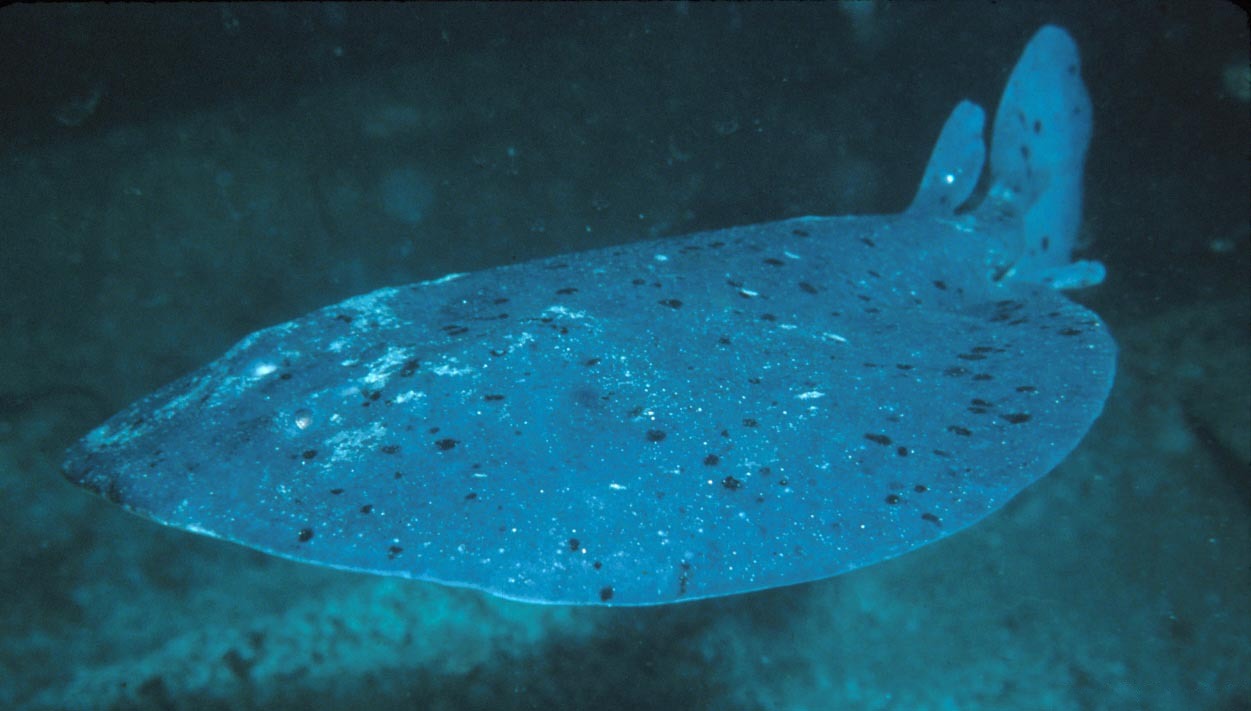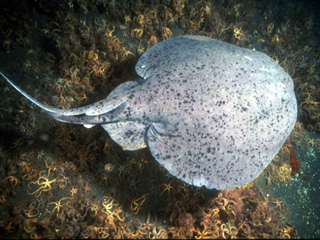|
Torpedinidae
The family Torpedinidae contains 22 species of electric rays or torpedoes, flat cartilaginous fishes that produce electricity as a defense and feeding mechanism. They are slow-moving bottom-dwellers. The largest species is the Atlantic torpedo, ''Tetronarce nobiliana'', which can grow to a weight of and deliver a 220-volt electric shock. Electric rays have patches of modified muscle cells called electroplaques that make up an electric organ. These generate an electric gradient, similar to the normal electric potential across most cell membranes, but amplified greatly by its concentration into a very small area. The electricity can be stored in the tissues, which act as a battery. The shock can be discharged in pulses. A ray can emit a shock into the body of a prey animal to stun it and make it easier to capture and eat, or into the body of a predator. Tissue from electric rays is often used in neurobiological research because of its unique properties. Torpedo rays are flat li ... [...More Info...] [...Related Items...] OR: [Wikipedia] [Google] [Baidu] |
Atlantic Torpedo
The Atlantic torpedo (''Tetronarce nobiliana'') is a species of electric ray in the family Torpedinidae. It is found in the Atlantic Ocean, from Nova Scotia to Brazil in the west and from Scotland to West Africa and off southern Africa in the east, occurring at depths of up to , and in the Mediterranean Sea. Younger individuals generally inhabit shallower, sandy or muddy habitats, whereas adults are more pelagic in nature and frequent open water. Up to long and weighing , the Atlantic torpedo is the largest known electric ray. Like other members of its genus, it has an almost circular pectoral fin disk with a nearly straight leading margin, and a robust tail with a large triangular caudal fin. Distinctive characteristics include its uniform dark color, smooth-rimmed spiracles (paired respiratory openings behind the eyes), and two dorsal fins of unequal size. Solitary and nocturnal, the Atlantic torpedo is capable of generating up to 220 volts of electricity to subdue its p ... [...More Info...] [...Related Items...] OR: [Wikipedia] [Google] [Baidu] |
Pacific Electric Ray
''Tetronarce californica'' also known as the Pacific electric ray is a species of electric ray in the family Torpedinidae, endemic to the coastal waters of the northeastern Pacific Ocean from Baja California to British Columbia. It generally inhabits sandy flats, rocky reefs, and kelp forests from the surface to a depth of , but has also been known to make forays into the open ocean. Measuring up to long, this species has smooth-rimmed spiracles (paired respiratory openings behind the eyes) and a dark gray, slate, or brown dorsal coloration, sometimes with dark spots. Its body form is typical of the genus, with a rounded pectoral fin disc wider than long and a thick tail bearing two dorsal fins of unequal size and a well-developed caudal fin. Solitary and nocturnal, the Pacific electric ray can generate up to 45 volts of electricity for the purposes of subduing prey or self-defense. It feeds mainly on bony fishes, ambushing them from the substrate during the day and actively hu ... [...More Info...] [...Related Items...] OR: [Wikipedia] [Google] [Baidu] |
Tetronarce Cowleyi
''Tetronarce'' is a genus of rays, commonly known as electric rays. They are slow-moving bottom-dwellers capable of generating electricity as a defense and feeding mechanism. ''Tetronarce'' species tend to attain a much larger size (up to 180 cm TL) than ''Torpedo A modern torpedo is an underwater ranged weapon launched above or below the water surface, self-propelled towards a target, with an explosive warhead designed to detonate either on contact with or in proximity to the target. Historically, such ...'' species, which are usually small to moderate sized (range from 25 to 80 cm TL) electric rays. Species There are currently nine recognized species in this genus:Carvalho, M.R. de. (2015): Torpedinidae. In : Heemstra, P.C., Heemstra, E. & Ebert, D.A. (Eds.), Coastal Fishes of the Western Indian Ocean. ''Vol. 1. South African Institute for Aquatic Biodiversity, Grahamstown, South Africa. In press.'' References Fish of Argentina Fish of Japan Fish ... [...More Info...] [...Related Items...] OR: [Wikipedia] [Google] [Baidu] |
Argentine Torpedo
''Tetronarce puelcha'', commonly known as the Argentine torpedo, is a species of fish in the family Torpedinidae. It is found in Argentina, Brazil, and Uruguay. Its natural habitat is open seas. It is rare electric ray fish species, which is moderately large (104 cm) found in South West Atlantic (mostly in Argentina and Brazil).Carvalho, M.R. de. (2015): Torpedinidae. In : Heemstra, P.C., Heemstra, E. & Ebert, D.A. (Eds.), Coastal Fishes of the Western Indian Ocean. ''Vol. 1. South African Institute for Aquatic Biodiversity, Grahamstown, South Africa. In press.'' It was first described in 1926 as ''Torpedo puelcha'' by Fernando Lahille. References External links ''Tetronnarce puelcha'': Occurrence datafrom GBIF The Global Biodiversity Information Facility (GBIF) is an international organisation that focuses on making scientific data on biodiversity available via the Internet using web services. The data are provided by many institutions from around the ... Tetronarc ... [...More Info...] [...Related Items...] OR: [Wikipedia] [Google] [Baidu] |
Tetronarce Formosa
''Tetronarce'' is a genus of Batoidea, rays, commonly known as electric rays. They are slow-moving benthic, bottom-dwellers capable of generating electricity as a defense and feeding mechanism. ''Tetronarce'' species tend to attain a much larger size (up to 180 cm total length, TL) than ''Torpedo (genus), Torpedo'' species, which are usually small to moderate sized (range from 25 to 80 cm total length, TL) electric rays. Species There are currently nine recognized species in this genus:Carvalho, M.R. de. (2015): Torpedinidae. In : Heemstra, P.C., Heemstra, E. & Ebert, D.A. (Eds.), Coastal Fishes of the Western Indian Ocean. ''Vol. 1. South African Institute for Aquatic Biodiversity, Grahamstown, South Africa. In press.'' References Tetronarce, Fish of Argentina Fish of Japan Fish of Taiwan Ray genera Taxa named by Theodore Gill {{Rajiformes-stub ... [...More Info...] [...Related Items...] OR: [Wikipedia] [Google] [Baidu] |
New Zealand Torpedo
''Tetronarce fairchildi'', commonly known as the New Zealand torpedo, is a species of electric ray of the family Torpedinidae found only around New Zealand, at depths of between 5 and 1,100 m. This species is placed in the genus ''Tetronarce''.Carvalho, M.R. de. (2015): Torpedinidae. In : Heemstra, P.C., Heemstra, E. & Ebert, D.A. (Eds.), Coastal Fishes of the Western Indian Ocean. ''Vol. 1. South African Institute for Aquatic Biodiversity, Grahamstown, South Africa. In press.'' In June 2018 the New Zealand Department of Conservation classified the ''T. fairchildi'' as "Data Deficient" under the New Zealand Threat Classification System The New Zealand Threat Classification System is used by the Department of Conservation to assess conservation priorities of species in New Zealand. The system was developed because the IUCN Red List, a similar conservation status system, had s .... References Endemic marine fish of New Zealand Ovoviviparous fish Tetronarce Fish desc ... [...More Info...] [...Related Items...] OR: [Wikipedia] [Google] [Baidu] |
Tetronarce
''Tetronarce'' is a genus of rays, commonly known as electric rays. They are slow-moving bottom-dwellers capable of generating electricity as a defense and feeding mechanism. ''Tetronarce'' species tend to attain a much larger size (up to 180 cm TL) than ''Torpedo A modern torpedo is an underwater ranged weapon launched above or below the water surface, self-propelled towards a target, with an explosive warhead designed to detonate either on contact with or in proximity to the target. Historically, such ...'' species, which are usually small to moderate sized (range from 25 to 80 cm TL) electric rays. Species There are currently nine recognized species in this genus:Carvalho, M.R. de. (2015): Torpedinidae. In : Heemstra, P.C., Heemstra, E. & Ebert, D.A. (Eds.), Coastal Fishes of the Western Indian Ocean. ''Vol. 1. South African Institute for Aquatic Biodiversity, Grahamstown, South Africa. In press.'' References Fish of Argentina Fish of Japan Fish ... [...More Info...] [...Related Items...] OR: [Wikipedia] [Google] [Baidu] |
Tetronarce Macneilli
''Tetronarce macneilli'', commonly known as the shorttail torpedo, is a species of large electric ray. The taxonomy of the species has been long debated and has been suggested that it is synonymous with ''Torpedo fairchildi''. Distribution and Habitat This species is found off of southern Australia from Port Hedland to the Swain Reefs in tropical-cool temperate waters. It is noted for having an unusually large range for a ray species. It inhabits sloped continental shelves and slopes from to . It feeds on fishes and crustaceans. Description ''T. macneilli'' can grow up to long. It is capable of delivering an intense electric shock if handled in defense and also uses this ability to hunt prey Predation is a biological interaction in which one organism, the predator, kills and eats another organism, its prey. It is one of a family of common feeding behaviours that includes parasitism and micropredation (which usually do not ki ....Compagno, L.J.V. & Last, P.R. (1999): ... [...More Info...] [...Related Items...] OR: [Wikipedia] [Google] [Baidu] |
Shigeho Tanaka
was a Japanese ichthyologist and professor of zoology at the Imperial University of Tokyo. He published numerous works on fishes and sharks and co-authored a book on Japanese fish with famous American scientist David Starr Jordan David Starr Jordan (January 19, 1851 – September 19, 1931) was the founding president of Stanford University, serving from 1891 to 1913. He was an ichthyologist during his research career. Prior to serving as president of Stanford Universi .... Publications Jordan, D. S., S. Tanaka, and J. O. Snyder. 1913. A catalogue of the fishes of Japan. J. Coll. Sci. Imp. Univ. Tokyo, Vol. 33 (article 1): 1–497. Tribute The genus Tanakia D. S. Jordan & W. F. Thompson 1914 was named for Tanaka, as an “accomplished” ichthyologist of the Imperial University of Tokyo, who described '' Tanakia shimazui'' in 1908 and '' Pseudorhodeus tanago'' in 1909. Taxon described by him *See :Taxa named by Shigeho Tanaka References *''Kochi University Biography' ... [...More Info...] [...Related Items...] OR: [Wikipedia] [Google] [Baidu] |
Fernando Lahille
Fernando Lahille (Fernand Lahille, born August 18, 1861, in Rouen, died July 30, 1940, French-Argentine scientist, ichthyologist and tunicate specialist. Lahille studied science and medicine at the University of Paris, receiving his doctorate in 1891 while publishing extensively. When in 1893 the Natural History Museum of La Plata in Argentina sought a scientist to head the newly formed zoology department, they found him in Lahille, already with eight years of experience in the marine laboratories of Banyuls-sur-mer and Roscoff, and sixty published works with the thesis on tunicate taxonomy (''Recherches sur les tuniciers'') being the most ground-breaking. During six years at the museum in Argentina (1893~1898), Lahille created a marine research station on the edge of Mar del Plata and initiated scientific studies of the continental shelf off Argentina. He also participated in two research trips to investigate the natural resources along the Patagonian coastline. Lahille subseque ... [...More Info...] [...Related Items...] OR: [Wikipedia] [Google] [Baidu] |
Gilbert Percy Whitley
Gilbert Percy Whitley (9 June 1903 – 18 July 1975) was a British-born Australian ichthyologist and malacologist who was curator of fishes at the Australian Museum in Sydney for about 40 years. Early life and education Gilbert Percy Whitley was born on 9 June 1903 at Swaythling, Southampton, England, the eldest child of Percy Nathan Whitley and Clara Minnie (née Moass). He was educated first at King Edward VI School, Southampton and then Osborne House School in Romsey, Hampshire. Whitley migrated with his family to Sydney Sydney is the capital city of the States and territories of Australia, state of New South Wales and the List of cities in Australia by population, most populous city in Australia. Located on Australia's east coast, the metropolis surrounds Syd ... in 1921. He started working at the Australian Museum in 1922, while studying zoology at Sydney Technical College and the University of Sydney. Career In 1925 Whitley was formally appointed to the title of ... [...More Info...] [...Related Items...] OR: [Wikipedia] [Google] [Baidu] |



